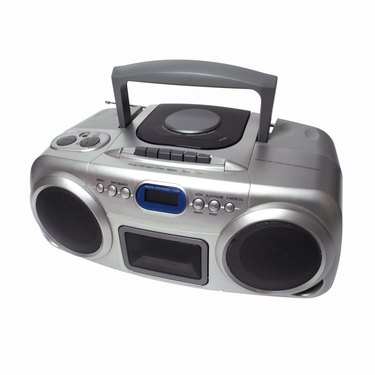
The annoying buzz of static is the last thing you want to hear when you're listening to the radio. Although most electronic and electrical equipment generates some radio interference, most devices, including fluorescent lights, minimize noise with good technical design and careful installation. If your lights cause objectionable amounts of static, it may be due to defective components or bad wiring.
Lamps and Ballast
Video of the Day
A fluorescent light fixture has two electrical components that play a role in radio noise: the lamps themselves and the ballast. The lamps are glass tubes containing a thin mercury vapor; the vapor conducts electricity and produces light. Unlike a standard light bulb, a fluorescent lamp needs a brief high-voltage kick-start to get it going; after start-up, the lamp runs at the standard 120 volts AC but uses very little current. The lamp can produce radio interference if problems exist with the internal wiring, the ballast or the lamp connections.
Video of the Day
Inspect the Wiring
To reduce radio noise, the ballast requires a electrical ground with low resistance and solid connections. With the lamp turned off, remove the lamp cover and follow the ballast's ground wire back to the electrical system ground; connections between wires should be tightly joined and free of dirt, debris or green copper oxide. The system ground itself should lead back to the breaker box or cold water pipe ground. In addition, the wiring in the fixture between the ballast and the bulbs should be as short as possible; longer wires act as antennas, sending electrical noise throughout the room. If you have any doubts about your abilities with electrical equipment, hire an experienced electrician to do the work.
Check the Lamps
Long fluorescent bulbs have four metal pins that connect to contacts in the fixture. The pins can become dirty or corroded, or strong vibration may work them slightly loose. Pins that aren't making firm contact may contribute to electrical noise and radio static, but the problem is easy to remedy: Simply remove the bulbs from the fixture, clean any corrosion from the pins and put them back in. Compact fluorescent lamps -- CFLs -- have a standard Edison screw-type base that is less prone to contact problems.
Replace the Ballast
Although ballasts are fairly durable and can last decades, they may experience failures due to age, operating conditions or manufacturing defects. If the lamp's wiring and grounding are well-fastened and electrically sound, the ballast itself may be failing if you're hearing excessive radio static. Replace the ballast with a new one of the same type.